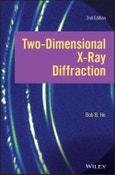An indispensable resource for researchers and students in materials science, chemistry, physics, and pharmaceuticals
Written by one of the pioneers of 2D X-Ray Diffraction, this updated and expanded edition of the definitive text in the field provides comprehensive coverage of the fundamentals of that analytical method, as well as state-of-the art experimental methods and applications. Geometry convention, x-ray source and optics, two-dimensional detectors, diffraction data interpretation, and configurations for various applications, such as phase identification, texture, stress, microstructure analysis, crystallinity, thin film analysis, and combinatorial screening are all covered in detail. Numerous experimental examples in materials research, manufacture, and pharmaceuticals are provided throughout.
Two-dimensional x-ray diffraction is the ideal, non-destructive analytical method for examining samples of all kinds including metals, polymers, ceramics, semiconductors, thin films, coatings, paints, biomaterials, composites, and more. Two-Dimensional X-Ray Diffraction, Second Edition is an up-to-date resource for understanding how the latest 2D detectors are integrated into diffractometers, how to get the best data using the 2D detector for diffraction, and how to interpret this data. All those desirous of setting up a 2D diffraction in their own laboratories will find the author’s coverage of the physical principles, projection geometry, and mathematical derivations extremely helpful.
- Features new contents in all chapters with most figures in full color to reveal more details in illustrations and diffraction patterns
- Covers the recent advances in detector technology and 2D data collection strategies that have led to dramatic increases in the use of two-dimensional detectors for x-ray diffraction
- Provides in-depth coverage of new innovations in x-ray sources, optics, system configurations, applications and data evaluation algorithms
- Contains new methods and experimental examples in stress, texture, crystal size, crystal orientation and thin film analysis
Two-Dimensional X-Ray Diffraction, Second Edition is an important working resource for industrial and academic researchers and developers in materials science, chemistry, physics, pharmaceuticals, and all those who use x-ray diffraction as a characterization method. Users of all levels, instrument technicians and X-ray laboratory managers, as well as instrument developers, will want to have it on hand.
Table of Contents
Preface xiii
1. Introduction 1
1.1 X-Ray Technology, a Brief History, 1
1.2 Geometry of Crystals, 2
1.3 Principles of X-Ray Diffraction, 11
1.4 Reciprocal Space and Diffraction, 13
1.5 Two-Dimensional X-Ray Diffraction, 19
References, 26
2. Geometry and Fundamentals 29
2.1 Introduction, 29
2.2 Diffraction Space and Laboratory Coordinates, 31
2.3 Detector Space and Detector Geometry, 35
2.4 Sample Space and Goniometer Geometry, 46
2.5 Transformation from Diffraction Space to Sample Space, 50
2.6 Reciprocal Space, 52
2.7 Summary, 53
References, 55
3. X-Ray Source and Optics 57
3.2 X-Ray Optics, 63
References, 85
4. X-Ray Detectors 87
4.1 History of X-Ray Detection Technology, 87
4.2 Point Detectors in Conventional Diffractometers, 89
4.3 Characteristics of Point Detectors, 92
4.4 Line Detectors, 100
4.5 Characteristics of Area Detectors, 107
4.6 Types of Area Detectors, 119
References, 137
5. Goniometer and Sample Stages 141
5.1 Goniometer and Sample Position, 141
5.2 Goniometer Accuracy, 145
5.3 Sample Alignment and Visualization Systems, 149
5.4 Environment Stages, 151
References, 155
6. Data Treatment 157
6.1 Introduction, 157
6.2 Non-Uniform Response Correction, 157
6.3 Spatial Correction, 161
6.4 Detector Position Accuracy and Calibration, 166
6.5 Frame Integration, 177
6.6 Multiple Frame Merge, 186
6.7 Scanning 2D Pattern, 194
6.8 Lorentz, Polarization, and Absorption Corrections, 197
References, 208
7. Phase Identification 211
7.1 Introduction, 211
7.2 Relative Intensity, 212
7.3 Geometry and Resolution, 216
7.4 Sampling Statistics, 221
7.5 Preferred Orientation Effect, 227
References, 233
8. Texture Analysis 235
8.1 Introduction, 235
8.2 Pole Density and Pole-Figure, 236
8.3 Fundamental Equations, 238
8.4 Data Collection Strategy, 242
8.5 Texture Data Process, 251
8.6 Orientation Distribution Function, 256
8.7 Fiber Texture, 261
8.8 Polymer Texture, 264
8.9 Other Advantages of XRD2 for Texture, 268
References, 269
9. Stress Measurement 271
9.1 Introduction, 271
9.2 Principle of X-ray Stress Analysis, 280
9.3 Theory of Stress Analysis with XRD2, 292
9.4 Process of Stress Measurement with XRD2, 307
9.5 Experimental Examples, 325
A9.1 Calculate Principal Stresses, 349
A9.2 Calculate the direction cosines for principal stresses (Eigenvectors), 350
References, 353
10. Small Angle X-ray Scattering 357
10.1 Introduction, 357
10.2 2D SAXS Systems, 361
10.3 Applications Examples, 367
10.4 Some Innovations in 2D SAXS, 370
References, 374
11. Combinatorial Screening 379
11.1 Introduction, 379
11.2 XRD2 Systems for High Throughput Screening, 380
11.3 Combined Screening with XRD2 and Raman, 390
Reference, 393
12. Miscellaneous Applications 395
12.1 Percent Crystallinity, 395
12.2 Crystal Size, 402
12.3 Retained Austenite, 412
12.4 Crystal Orientation, 414
12.5 Thin Film Analysis, 418
Reference, 429
13. Innovation and Future Development 433
13.1 Introduction, 433
13.2 Scanning Line Detector for XRD2, 434
13.3 Three-Dimensional Detector, 438
13.4 Pixel Direct Diffraction Analysis, 441
13.5 High Resolution Two-Dimensional X-Ray Diffractometer, 444
References, 451
Appendix A. Values of Commonly Used Parameters 453
Appendix B. Symbols 459
Index 465








